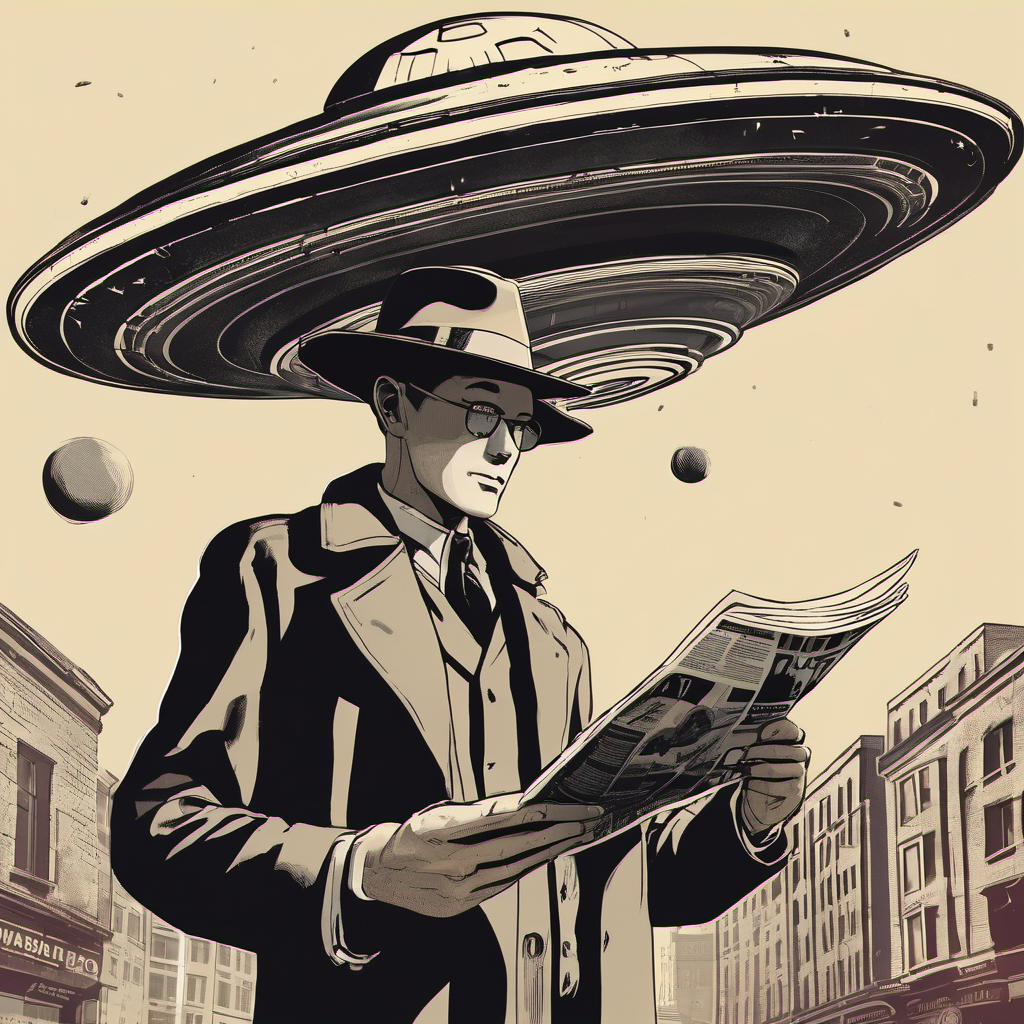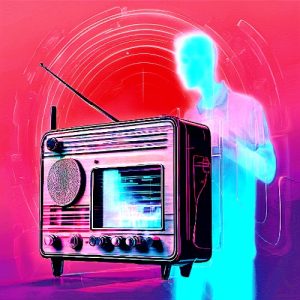 By KEN KORCZAK
By KEN KORCZAK
Thousands of ghost hunters today routinely use electronic devices to capture “voices of the dead” — but is there serious science behind it?
On October 21, 1987, Swedish photographer Claude Thorlin turned on his television set to Channel 4, only to find a blank screen. That was expected, however, because 37 years ago this area of Sweden had just two channels of dicey reception and Channel 4 was not one of them.
Even so, Thorlin’s wife insisted that they continue to monitor the channel because she had received a “strong psychic impression” to do so the night before. After about one-half hour, the couple was intrigued to see a shimmering form of light appear on the screen.
Claude Thorlin grabbed a Polaroid camera and snapped a picture. When he developed it, he was stunned to see a ghostly image of their recently deceased friend, the world-renowned painter, film maker and opera singer, Friedrich Jürgenson.
Thorlin captured the photo of Jürgenson during the very same hour his funeral was taking place a few hundred miles away in another part of Sweden. That could hardly have been a coincidence. Thorlin subsequently checked with every TV station in Sweden and confirmed that none had broadcast an image of Jürgenson.
It seemed the just deceased Jürgenson was determined to send a message to his friends Claude and Ellen Thorlin. In other words: “He made it!” That is, his consciousness had survived the death of his body — and now he was communicating “back to Earth” from “the Other Side” via the electronic apparatus of a television set.
OF COURSE IT WAS JURGENSON
It would be difficult to select a more appropriate candidate to appear as an “electronic ghost image” on a blank TV screen than the Ukrainian-born Friedrich Jürgenson. That’s because today he is known as “The Father of EVP.”
What is EVP? It stands for Electronic Voice Phenomenon. It’s the practice of using radios and various recording devices to capture the “voices of the dead” — or should I say, “people that are still alive after shedding their physical bodies and continuing their existence in some form of afterlife environment.”
Jürgenson gave up a lucrative and flourishing career as a world-recognized artist, film maker and singer to devote all his time to studying “the voices.” Jürgenson — a nonreligious nonbeliever — captured his first recording by accident one spring day in 1959.
He was attempting to record the sound of birds outside his isolated rural cabin near Mölnbo, Sweden. When he played back his reel-to-reel tape, he was stunned to hear what sounded distinctly like human voices intruding into the sounds of nature.
As he continued to make recordings, he soon captured a voice he was convinced was his deceased mother. Jürgenson heard:
“Friedel, can you hear me? It’s mammy …”
“It was my dead mother’s voice,” Jürgenson said. “Friedel was her special nickname for me.”
Jürgenson became obsessed with recording more of these mysterious voices. He was soon working on the project 18 hours per day. He kept at it for decades until he died in 1987. He published a book titled Voices from Space. Interestingly, and as the title suggests, Jürgenson’s first working theory on the origin of the voices was that they might be transmitted by UFOs!
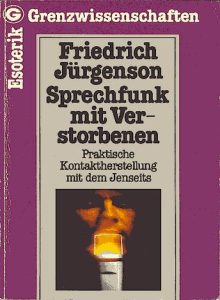 He eventually released an updated version titled Voice Transmission with the Deceased; a book now considered a classic in the field. You can read an English translation of this book for free here: Voice Transmission with the Deceased.
He eventually released an updated version titled Voice Transmission with the Deceased; a book now considered a classic in the field. You can read an English translation of this book for free here: Voice Transmission with the Deceased.
Jürgenson’s unusual practice received eager coverage from the mainstream media. Although he was not the first to record anomalous voices that seemed to be made by “spirits,” Jürgenson was the first to develop it formally as a discipline. He provided thousands of samples of his recordings to the press and European scientists from an array of disciplines.
More on Jürgenson in a bit, but first a little context:
A NEW SCIENCE DEVELOPS
Today, EVP is more often called ITC or Instrumental Trans-Communication. (ITC Journal Website) That term was coined by German physicist Dr. Ernst Senkowski who experimented extensively in contact with the deceased via electronic equipment. Dr. Senkowski was intrigued by Jürgenson’s data and recordings.
A name more well-known in the ITC field than both Jürgenson and Senkowski, however, is Dr. Konstantin Raudive, a Latvian-born psychologist who studied under the great Carl Jung. Raudive was an internationally recognized writer, intellectual and professor of psychology at Sweden’s University of Uppsala.
Raudive read Jürgenson’s book and contacted him. The two men began working together to study EVP. However, they soon reached an impasse, disagreeing on the best way to move the research forward. Raudive went on to pursue a much more technical approach. In 1971, he published a groundbreaking book, Breakthrough: An Amazing Experiment in Electronic Communication with the Dead.
Even though Jürgenson received significant publicity from the international press, his work and reputation were eclipsed by Raudive’s book, despite the latter being tedious, technical and boring. It was exhaustively thorough, however, and a scientifically grounded study of EVP. So influential was Raudive’s work that EVP recordings are still sometimes called “Raudive Voices.”
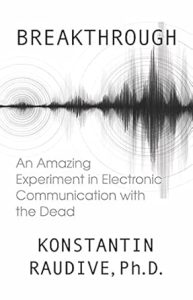 It’s fascinating to note that anomalous voice phenomena have been noticed nearly since nearly the beginning of recording technology. Thomas Edison invented the first phonograph in 1877. It used tinfoil wrapped around a cylinder as a medium to capture sound. The device was powered by “elbow grease.” — that is, it was not electronic and had to be turned by hand.
It’s fascinating to note that anomalous voice phenomena have been noticed nearly since nearly the beginning of recording technology. Thomas Edison invented the first phonograph in 1877. It used tinfoil wrapped around a cylinder as a medium to capture sound. The device was powered by “elbow grease.” — that is, it was not electronic and had to be turned by hand.
By the turn of the century, advances in recording technology produced better recording mediums, such as ceresin, beeswax and stearic wax.
In 1901, the Russian ethnographer Vladimir Bogoraz traveled to a remote region of Siberian to study the shamanistic Chukchi culture. He used a mechanical phonograph device that deployed a wax cylinder — it was also a hand-driven “acoustic” device — electronic applications to recording did not become commercially available until 1925.
Bogoraz recorded a Chukchi shaman as he performed a drumming ceremony to call forth various forms of “spirits.” Amazingly, when Bogoras played back the recording, he was stunned to hear both English and Russian voices intruding on the playback. Neither of these voices was heard by the human ear while recording. No one in the expedition party spoke English.
It seems the Chukchi shaman knew what he was doing!
He called forth not just the traditional ancestral spirits, elementals, totems and demigods of the Chukchi ancient belief system, but some “random dead Europeans” decided to show up as well!
At least one of these Bogoraz recordings was studied at the University of Minnesota by physicists. The voices in question remain unexplained, albeit controversial.
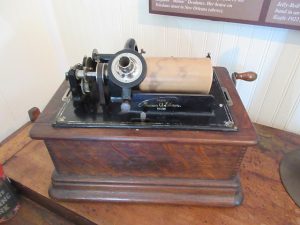
Fast forward to 1941, and we find a Hungarian-American photographer by the name of Attila Von Szalay who used 78 rpm disks made of shellac to experiment with EVP. His successes were limited and few but always intriguing. Later, when reel-to-reel tape came along, Szalay found much greater success. He was able to capture numerous anomalous voices that said super profound things like, “This is G!” and “Merry Christmas and a Happy New Year to you All!”
Szalay teamed up with American artist Raymond Bayless for a more intensive study of anomalous voice recording. Together, they made advances in capturing “voices from the void” as they sometimes called them. Bayless would eventually publish an influential book titled Phone Calls from the Dead co-authored by the bestselling paranormal author D. Scott Rogo.
Another notable unforeseen breakthrough in EVP occurred in 1952 when Father Agostino Gemelli, a Catholic priest who was also a neurophysiologist, was working on restoring recordings of Gregorian chants. When playing back his tapes one day, he was stunned to hear the unmistakable voice of his deceased father calling out to him.
Father Gemelli was so freaked out that he took the recordings to the Pope himself. Gemelli did so despite fearing rebuke and sanctions from the Holy Father because of the Catholic Church’s well-known policy of condemning such practices as mediumship, seances and occult activity.
However, Pius XI embraced the idea and told Father Gemelli he had done nothing wrong. Pius felt that because the voices were captured by a “neutral machine,” it was therefore fully objective and not the same as a person opening his or her mind to the spirit world.
JURGENSON UNIQUELY QUALIFIED
Friedrich Jürgenson was unaware of any of this when he spontaneously captured his first “voices of the dead” in 1959. He was a nonreligious man who had no interest in parapsychology or paranormal phenomena.
As it turns out, though, Jurgenson was ideally suited to recognize anomalous voice recordings for what they are. Remember what Louis Pasteur said: “Chance favors the prepared mind.” Jürgenson was not prepared to encounter the paranormal, per se — but his skill sets made him an ideal “prepared mind” for the strange journey he was about the take. Consider:
–> He was a polyglot. That is, he spoke at least six languages fluently and had a working comprehension of at least 10 languages.
–> He had an extremely refined sense of hearing. That was because he began intensive training as a singer when he was a child. His teachers hammered home to him the importance of “listening to each note” and “isolating specific modulation of voice” and musical instruments to gain a supreme command of operatic performance.
–> As a world-class painter, Jurgenson honed his observational skills and learned to winnow out the nuances and subtleties of sight, colors and the complex interactions of sun, shadows and light on our perceptions of reality.
Jürgenson noticed immediately that the voices he recorded routinely created sentences that mashed together a half-dozen languages. A single “message” could be part Swedish, German, Russian, Arabic, French and more — languages all of which Jurgenson understood.
His acute hearing enabled Jürgenson to “isolate” anomalous voices or messages incorporated (or mixed in) with all other background noises. Remember, the first voices he heard were interlaced within the sounds of birds, rustling leaves and wind.
Jürgenson soon discovered that voices could be heard embedded within the music and the standard dialogue broadcast across commercial radio stations. The latter became his preferred method of capturing spirit voices.
Over the past 70 years, or so, EVP practitioners have determined that some form of background noise is conducive to better results. The theory is that those on “The Other Side” must leverage the ambient soundscape they find here as the “raw material” to manufacture the words they want to transmit to us.
On the other hand, examples of EVP voices have been captured in situations where the recording environment is silent. Indeed, voices have been recorded by devices inside Faraday cages, also called Faraday shields.
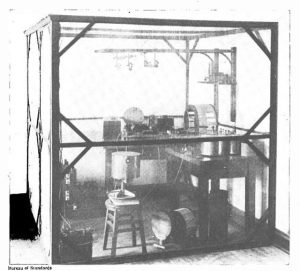
Faraday cages are boxes or entire rooms enclosed in conductive materials, such as copper, that prevent electromagnetic fields from entering. That all but rules out “stray transmissions” from outside radio stations, walkie-talkies, ham radios and the like.
Of course, even EVP captured inside Faraday cages is not enough to mollify the skeptics. Scoffers and debunkers easily (they think) write off EVP recordings as “imaginative interpretation,” “wishful thinking,” stray voices captured from ordinary broadcasts — such as ham radio skips — and audio pareidolia — not to mention a favorite skeptic go-to debunking tool: Hoaxing.
A NEW COTTAGE INDUSTRY EMERGES
One of the leading figures in EVP today is Anabela Cardoso, Ph.D., a former high-ranking Portuguese senior diplomat who — like Jürgenson — abandoned a thriving, well-paid career to devote all her time to communication with voices of the deceased or whatever their origin.
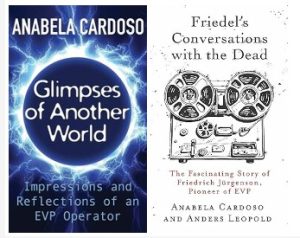 She recently published a book on the life and work of Jürgenson. I also read another of her books, Glimpses of Another World. I will review this book in my next article.
She recently published a book on the life and work of Jürgenson. I also read another of her books, Glimpses of Another World. I will review this book in my next article.
Anyway, in a recent interview with psychologist Jeffrey Mishlove on his New Thinking Allowed program, Cardoso decried the current state of EVP research suggesting that serious study of the phenomenon by scientists and academics has fallen away in recent years.
However — and for better or worse — EVP has since become democratized, so to speak. It has been embraced by the masses, or at least a significant cultural niche of society. EVP has emerged as a cottage industry over the past decade as numerous devices specially designed for capturing voices of the dead are now competing on the market. The selection is vast!
Consider this image from a search I did on “Commercially available spirit boxes:”

That’s right! There is a “Huge selection!” of ready-to-go, plug-n-play radio receivers that are specifically configured to tune in the voices of the dead!
This new market was supercharged by the popularity of the first prime-time ghost-hunting program, Ghost Hunters, fronted by two plumbers, Jason Hawes and Grant Wilson. The show ran for 11 seasons over 12 years and spawned uncounted hundreds of amateur groups to get into the ghost-hunting game worldwide, not to mention numerous copycat TV shows and movies.
Serious EVP researchers like Cardoso are circumspect about all this “pop culture” voice recording because they say it is unscientific, not disciplined and geared toward making popular TV shows and generating clicks for ghost-hunting groups on their Facebook pages and other social media platforms.
Whatever the case, EVP and ITC have now infused themselves into our culture. A tiny few serious researchers continue to study the phenomenon in laboratory settings while the thousands of avid, semi-serious and fun-loving ghost-hunter types thrill at the adventure of capturing the “voices of the dead.”
NOTE: For more stories on paranormal topics, please see: KEN-ON-MEDIUM
